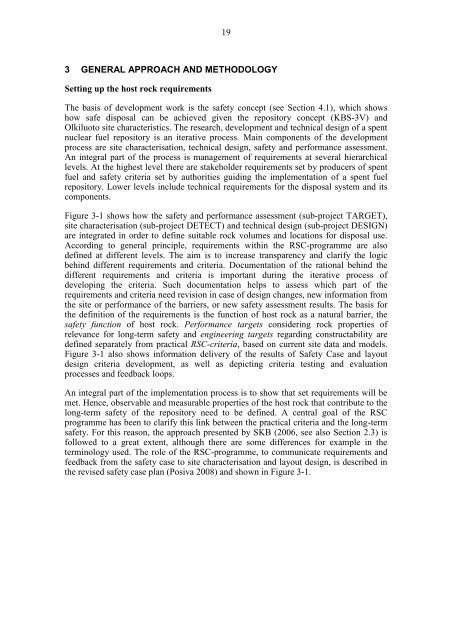RSC-Programme - Interim Report. Approach and Basis for - Posiva
RSC-Programme - Interim Report. Approach and Basis for - Posiva
RSC-Programme - Interim Report. Approach and Basis for - Posiva
Create successful ePaper yourself
Turn your PDF publications into a flip-book with our unique Google optimized e-Paper software.
193 GENERAL APPROACH AND METHODOLOGYSetting up the host rock requirementsThe basis of development work is the safety concept (see Section 4.1), which showshow safe disposal can be achieved given the repository concept (KBS-3V) <strong>and</strong>Olkiluoto site characteristics. The research, development <strong>and</strong> technical design of a spentnuclear fuel repository is an iterative process. Main components of the developmentprocess are site characterisation, technical design, safety <strong>and</strong> per<strong>for</strong>mance assessment.An integral part of the process is management of requirements at several hierarchicallevels. At the highest level there are stakeholder requirements set by producers of spentfuel <strong>and</strong> safety criteria set by authorities guiding the implementation of a spent fuelrepository. Lower levels include technical requirements <strong>for</strong> the disposal system <strong>and</strong> itscomponents.Figure 3-1 shows how the safety <strong>and</strong> per<strong>for</strong>mance assessment (sub-project TARGET),site characterisation (sub-project DETECT) <strong>and</strong> technical design (sub-project DESIGN)are integrated in order to define suitable rock volumes <strong>and</strong> locations <strong>for</strong> disposal use.According to general principle, requirements within the <strong>RSC</strong>-programme are alsodefined at different levels. The aim is to increase transparency <strong>and</strong> clarify the logicbehind different requirements <strong>and</strong> criteria. Documentation of the rational behind thedifferent requirements <strong>and</strong> criteria is important during the iterative process ofdeveloping the criteria. Such documentation helps to assess which part of therequirements <strong>and</strong> criteria need revision in case of design changes, new in<strong>for</strong>mation fromthe site or per<strong>for</strong>mance of the barriers, or new safety assessment results. The basis <strong>for</strong>the definition of the requirements is the function of host rock as a natural barrier, thesafety function of host rock. Per<strong>for</strong>mance targets considering rock properties ofrelevance <strong>for</strong> long-term safety <strong>and</strong> engineering targets regarding constructability aredefined separately from practical <strong>RSC</strong>-criteria, based on current site data <strong>and</strong> models.Figure 3-1 also shows in<strong>for</strong>mation delivery of the results of Safety Case <strong>and</strong> layoutdesign criteria development, as well as depicting criteria testing <strong>and</strong> evaluationprocesses <strong>and</strong> feedback loops.An integral part of the implementation process is to show that set requirements will bemet. Hence, observable <strong>and</strong> measurable properties of the host rock that contribute to thelong-term safety of the repository need to be defined. A central goal of the <strong>RSC</strong>programme has been to clarify this link between the practical criteria <strong>and</strong> the long-termsafety. For this reason, the approach presented by SKB (2006, see also Section 2.3) isfollowed to a great extent, although there are some differences <strong>for</strong> example in theterminology used. The role of the <strong>RSC</strong>-programme, to communicate requirements <strong>and</strong>feedback from the safety case to site characterisation <strong>and</strong> layout design, is described inthe revised safety case plan (<strong>Posiva</strong> 2008) <strong>and</strong> shown in Figure 3-1.
















